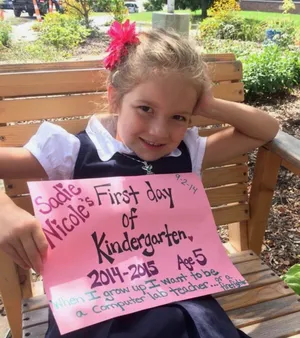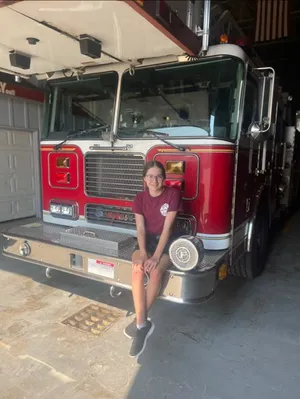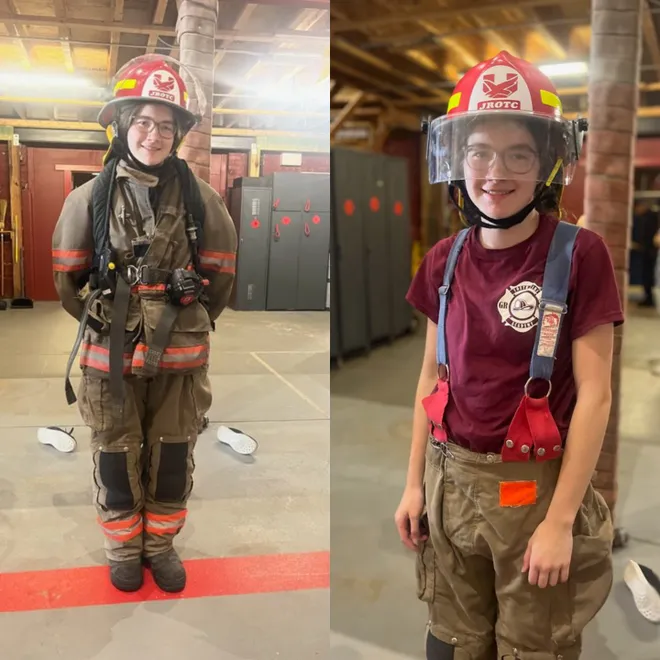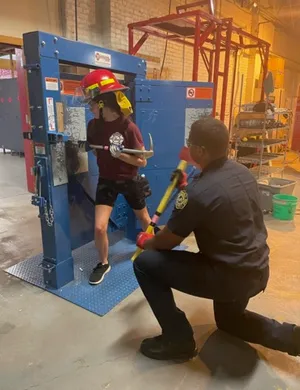'You can't be what you can't see': How fire camps are preparing young women to enter the workforce
Sadie Morgan had a feeling she wanted to be a firefighter back when she was in kindergarten.
A photo from her first day of school shows the smiling little girl holding a sign that reads, “When I grow up, I want to be a computer lab teacher…or a firefighter.”
She’s now 14 and a freshman in high school living in Grand Rapids, Michigan and while she is not a firefighter yet, she did complete the Grand Rapids Fire Department’s Youth Fire Academy.
The week-long program allows students to learn search and rescue drills, use fire hose lines and extinguishers and perfect hands-only CPR.
Sadie’s therapist told her about the program, but when she inquired about it, she saw that the age range was 15 to 18. With some encouragement from her parents, she reached out anyway in July to ask about participating.
“They're probably just going to tell me we love your interest but you'll have to wait until next year,” she told USA TODAY Friday morning. “I was just so surprised that they were going to let me in.”

Not only is Sadie younger than people who typically complete the program, but she’s also a young woman in an industry typically made up of men.
“Part of that’s just historical,” said Rachael Staebell, vice president of Women in Fire, a networking organization for firefighters. “It’s just the nature of the history of the fire service … but in the last 30 to 40 years … we've seen a huge growth of women looking to enter the field.”
That’s why academies like the one in Grand Rapids are important, Staebell told USA TODAY Friday morning.
The programs allow young women to get a brief glimpse into what firefighting is like and then decide if they want to keep it on their list of potential career paths.
“You can't be what you can't see,” Staebell said. “These gals are exposed to, at a younger age, firefighting. They know before they even have to go take a physical test or written test, ‘Hey, that's something I could go do.’”
Teenagers doing big things:American teenage boy recognized for having largest afro in the world by Guinness World Records
How the 14-year-old turned challenges into advantages
The program Sadie completed was at the Grand Rapids Fire Department's Training Center, Sadie's mother, Ella Morgan, confirmed. That allowed them to train using the same courses, exercises and equipment local firefighters do.
“As a parent, I was so excited for her but honestly I was also a little nervous because by the second day, they were running these students in simulations with the air tanks and the smoke-filled rooms and things like that."
There were about seven participants, including Sadie, she said.
Each day, they’d report to the training center just before 8 a.m. to clean up and then start training. They learned CPR, the heimlich, wore firefighter gear and completed drills.

One of the hardest parts of the academy was working with the hoses, Sadie shared. She’s smaller than the other participants so it was hard to get around corners and make sharp turns up the stairs.
“But I also knew how to use my strengths to my advantage,” she said. “I have pretty good leg strength so I knew how to use that to help propel myself forward. I was too stubborn to not try my best and not to get it done.”
Being smaller than the rest of the group helped Sadie because she was able to jump over things much easier than others. Her smaller size also made crawling through small spaces simpler.
Like most people who try something new, the 14-year-old go-getter was a bit nervous about completing the program, but said she had tons of support.
“It was all very equal between me and the other participants,” she shared.
A whale of a discovery:Alabama teen, teacher discover 34-million-year-old whale skull
Organization pushes for empowerment, equality in firefighting
While Sadie isn’t a firefighter yet, it’s important that young women like her are aware of programs like Youth Fire Academy because they help prepare youth for when it comes time to take written and agility tests, said Staebell, from Women in Fire.
Women in Fire was created to change the culture of fire service and support women who want to enter the field, Staebell shared.
Currently, about 4% of firefighters in the U.S. are women, she said. That doesn’t include volunteer fire departments. And because not many women have become firefighters, some accommodations have never been needed or thought of.
Some gear doesn’t fit women properly, but it’s more cost-efficient for fire departments to buy one standard uniform, she said.
Some fire stations don’t even have women’s restrooms because the buildings are very dated. And add to that the need to breastfeed, she said. Some don’t have spaces where women can do any of that.
It’s also difficult to find boots and fire gloves that fit women’s hands, which are sometimes smaller.
“There's a whole number of things that because we just weren’t there, weren’t needed,” Staebell shared. “And now they're needed. A lot of places are facing some issues with budget, and it is expensive to retrofit stations and it is expensive to deal with all these things but ultimately, it's the right thing to do.”
Staebell sees a rise in fire service leaders trying to accommodate women though, which has benefited some men as well who weren’t satisfied with the fit of their gear.

Fire academy programs set young women up for success
Camps such as the one in Grand Rapids help young women prepare for careers in firefighting by teaching them about fire hoses, fire safety and some even include training on vehicle extrication, or rescuing people who have been in car accidents, Staebell said.
“Some of the camps will introduce these gals to not only firefighting, but also other public safety things,” she said. “Some camps will bring in a dispatcher to come talk. They'll introduce these gals to law enforcement as well, another career that's historically not got a lot of women in it.”
It differs from program to program, but the goal is to introduce the young women to public safety, show them they can do things they never thought possible and give them the push they need to pursue it.
The programs also help them prepare for written and agility tests they’ll have to take if they truly want to become firefighters, Staebell said. Many people falsely believe if women apply for firefighting jobs and test, they'll be sure to get a job. It doesn’t work that way though.
“If you're a woman and you're testing, you’ve got to put yourself in that top half of that group if you even want to be looked at,” she said. “Being a woman alone is not enough to get hired. But if you are equal to your counterparts, and let's say you’re second or third on that list, there's no reason you're not going to get picked up.”

What’s next for Sadie?
Sadie, the aspiring firefighter in Michigan, plans to complete the Youth Fire Academy again until she ages out at 18. She also has a ridealong scheduled Monday with the fire department and plans to volunteer at the fire department’s headquarters.
“I’ll be able to watch real firefighters in action, learning what they're doing and just bettering my knowledge about the community and the job,” Sadie shared.
Sadie’s mom, Ella, said she knew from the very beginning that her daughter had a giving heart and was destined to be a trailblazer.
Her mother said she may grow up and become a firefighter or she could be an EMT. Whatever she does will be people-centered because that’s just the type of person she is.
“She will continue this heart of love for others and wanting to care for those that sometimes maybe are overlooked in our community,” her mother said. “Public service will definitely be in her path, whatever route she chooses.”
For a list of fire camps in the U.S., check out www.tinyurl.com/FireCamps.
Disclaimer: The copyright of this article belongs to the original author. Reposting this article is solely for the purpose of information dissemination and does not constitute any investment advice. If there is any infringement, please contact us immediately. We will make corrections or deletions as necessary. Thank you.

